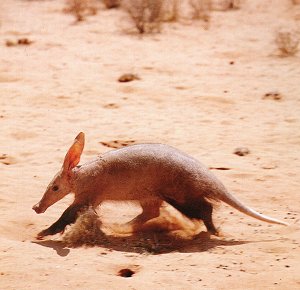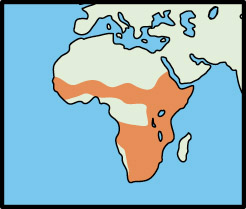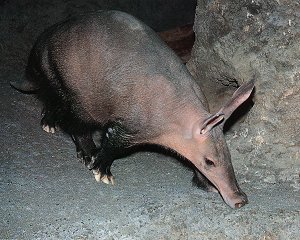THE ORDER TUBULIDENTATA
Tubulidentata – Tube Toothed Mammals (One species.)
Perhaps we think of the aardvark only as being the first word in the dictionary, but it is so extraordinary among mammals that it is placed in order all by itself. Although it eats ants and termites, the aardvark is not closely related to the anteaters, but this is just another example of the convergence of two different types of animals adapting to the same habitat.

The aardvark is a homely beast that looks something like a long-nosed, rabbit-eared pig. Its name means “earth-pig” in Afrikaans. It is found in Africa in areas where its main diet – ants and termites – are in abundant supply. It also indulges in locusts or grasshoppers occasionally. But it is well adapted to a specialized diet of ants and termites because it has strong limbs and heavy claws which easily dig into termite mounds. To give you an idea of the strength of its forelimbs and claws, a human would have to wield an ax to break into the concrete-like termite mounds in Africa. Also, it has a long sticky tongue, thick skin, and an acute sense of smell. Incisor and canine teeth are absent, but the aardvark has on each side of its mouth five uppers and four lower cheek teeth which are peculiarly tubular in structure. It is from this feature that the name of the order is derived – Tubulidentata.
The aardvark has few predators because it can fight fiercely with the claws of its forefeet, and its skin is quite thick. Hyenas are occasionally hungry enough to try, but only the young, the old, and the sick are easy prey for the other carnivores. However, its habitat is shrinking with the encroachment of human civilization, and although it is not yet endangered, there are legal sanctions against trading in their products.
 Skeletal evidence suggests that the aardvark descended from primitive ungulates, the hoofed animals, such as deer and zebras, breaking away about 65,000,000 years ago during the Paleocene. There is so much about the aardvark that is unique, that they are referred to by some scientists as “living fossils.”
Skeletal evidence suggests that the aardvark descended from primitive ungulates, the hoofed animals, such as deer and zebras, breaking away about 65,000,000 years ago during the Paleocene. There is so much about the aardvark that is unique, that they are referred to by some scientists as “living fossils.”
Aardvark – ORYCTEROPUS AFER
Possibly Endangered
- Class: Animals with Milk Glands (Mammalia)
- Subclass: True Mammals (Eutheria)
- Order: Tube Teeth (Tubulidentata)
- Family: Orycteropidse.
 The Name “aardvark”: This word comes from the South African “Afrikaans,” a language derived from Dutch, and means “earth pig,” (literally: “earth pork” from its Latin roots).
The Name “aardvark”: This word comes from the South African “Afrikaans,” a language derived from Dutch, and means “earth pig,” (literally: “earth pork” from its Latin roots).
Location: Africa South of the Sahara.
Habitat: Terrestrial. Savanna, grasslands, and open forests where the ground is soft.
Description: This is a fairly large creature, with a curved back and a cylindrical, rather piglike snout, from whence its name. Its ears are long and tough, and it has strong feet with four toes on the front foot and five on the back. All the toes have large claws for digging. The grayish skin is thick and bare except for a few scattered hairs. The aardvark grows about 40 to 60 in long, with the tail extending another 18 to 24 inches. It weighs from 175 to 200 lbs.

Behavior: This is the only living representative of the Tubulidentata order. The aardvark is a completely nocturnal creature and very difficult to observe since it spends the day in its burrow. It is an exceptional digger and can disappear underground rapidly, especially when danger is near. Its tunnel system can sometimes be long and complex, with numerous openings, but they invariably lead eventually to a large chamber. Their tunnels are often used by other animals for shelter, as well. The aardvark feeds on termites, which it pulls into its mouth with a long sticky tongue.
Reproduction: The aardvark is a solitary animal unless you see the female accompanied by one or more of her young. Gestation takes about seven months for a single offspring. The young are nursed for only a few months but will continue to remain with its mother several months after it has been weaned.
